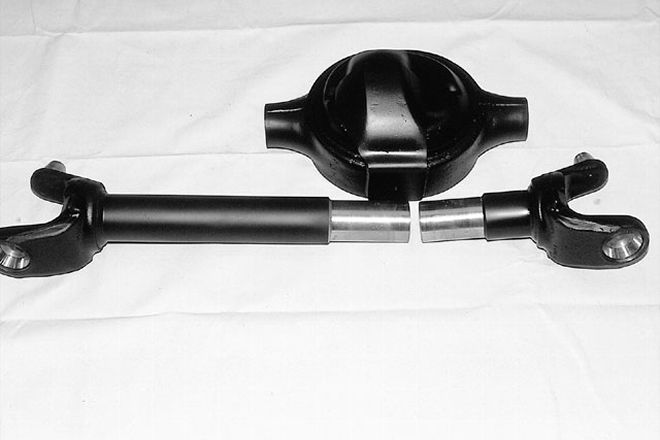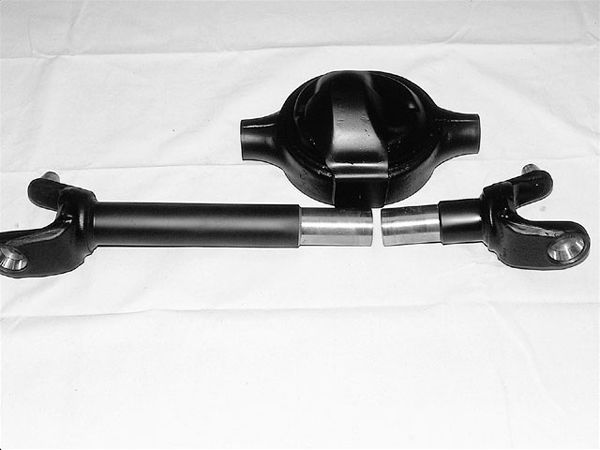
 John Cappa
Former Editor, Four Wheeler
Contributors:
Rob Harris
Photographers:
Rob Harris
John Cappa
Former Editor, Four Wheeler
Contributors:
Rob Harris
Photographers:
Rob Harris

Building a 4x4 is often a project that is never really finished. This can lead to wasted money when one part is scrapped in favor of a stronger one, that also ends up in the recycle bin a short time later. Axles are a good example of this phenomenon. Custom-built units may seem perfect at the time of purchase, but they are often broken when the continual buildup of your vehicle places more stress on the parts than you had originally anticipated. This means the gears, lockers, and everything else were a waste. The only way to avoid this kind of misfortune is to overbuild in the first place. If it's already too late for that, maybe you can use some of your old parts to build a hybrid axle.
A hybrid axle is the combination of the best parts from several different axles. In our case, a center section from a Ford 9-inch and the tubes and knuckles from a Dana 60 were used. This combination gave us weight savings (88 pounds more than a 9-inch front axle with CJ outer knuckles) and a small gain in ground clearance over a Dana 60. Best of all it saved money by retaining the 9-inch's locker and gears. Tom Elliston at Sunray Engineering actually prefers this 9-inch setup because it can be used in a spring-under suspension configuration. A Dana 60 front axle casting was never made to accept springs on the bottom side. On CJ- and YJ-width axles there isn't enough room for a perch. For high-horsepower applications it is beneficial to have the springs on the bottom. This reduces axlewrap and bouncing when you're on the gas.
Normally Spicer 5-297X axle U-joints are used when a Ford 9-inch front axle is built. These are 11/42-ton components often found in Dana 44s. The joints have a Brinell hardness of 1,250 lb-ft. Brinell hardness of a U-joint is measured by the amount of force required for the needle bearings in the U-joint caps to indent the trunion. Once the trunion is damaged the U-joint quickly wears out. Interestingly, some Spicer joints have been tested to almost 5,600 lb-ft before they broke. Under most circumstances 297s work well in the front of Jeeps and other lightweight vehicles. With aggressive driving, large tires, and big power, however, their time is limited. Dana 60s use monstrous 5-332X (1480 series) joints with a Brinell hardness of 3,330 lb-ft. That's over 211/42 times stronger than a 297. However, 60 shafts and U-joints don't just bolt into your 9-inch front axle.
It is also possible to do the 60 knuckle and tube swap on a Dana 44 axle, although a 44 in stock form is very well balanced. Sometimes an inner axle will break, sometimes a hub, and other times the U-joint or even the stub will let loose. Installing heavy-duty knuckles and U-joints will more than guarantee the 30-spline inner axles to become the weak links.
Elliston also believes that the 44 carrier bearing caps will distort under heavy loads and the ring-and-pinion gears are weak when a standard-rotation axle is used in the front. He did note that steel bearing caps are available for the 44 and that a reverse-rotation 44 is stronger than a standard-rotation in front-axle applications.
Using a 9-inch with 31-spline shafts isn't the strongest setup either, but the shafts are 10 percent stronger than the 44s 30-spline shafts. Ideally, a 35-spline Ford 9-inch should be used in abusive conditions. This would net a 42 percent increase in strength over the 31-spline version. Using 35-spline inner axles would make the 30-spline stub axles the weak links. Since we already had a 31-spline locker we decided that a 10 percent increase in axle strength over a Dana 44, and a 266 percent increase in U-joint strength over a 297 joint, was good enough. The photos and captions below show how Elliston built a 9-inch/ Dana 60 hybrid.
Buy the NumbersIf you are in the market to buy a custom-built axle it is important to know the numbers so you don't get stuck with an axle that will need to be swapped out or modified later. Everything from spline counts to gear and locker availability should be considered. Here are some facts to ponder.
Ford 9-inch The 9-inch is one of the few axles that has a removable carrier. It has a ring gear diameter of 9 inches. Common spline counts are 28, 31, and 35. Some expensive custom axles have 40 splines, but you can only get spools to work with these axles. One of the drawbacks of the 9-inch is its low-slung pinion. It sits 231/48 inches below the axle centerline. This can cause driveshafts to bind on short wheelbase vehicles, and the pinion often hits rocks. It's a good idea to have a small skidplate that protects the removable pinion support. Hard impacts can cause it to crack. Ratios ranging from 2.80:1 to 6.50:1 are available. The lowest point on the housing is 531/44 inches from the axle centerline. A high-pinion version of the 9-inch is available from Currie, but limited ratios are available for it (3.31:1 to 4.56:1). The pinion on the high-pinion model is 111/42 inches above the axle centerline, and the ring gear measures 8.8 inches. All other measurements are the same as the 9-inch, and the complete third-members are interchangeable. The high-pinion version is not recommended for vehicles with tires larger than 35 inches or engines pushing more than 500 hp.
Dana 60 The 60 has an integral carrier, making gear swaps a little more time consuming. It has a ring gear diameter of 931/44 inches. Common spline counts are 30 and 35. An aftermarket 40-spline version is available. The major drawback of a 60 is its weight. The pinion sits 111/48 inches below the axle centerline. That's 111/44 inches higher than a 9-inch. Many wrongly believe that the 60 hangs precariously low. The lowest point is 6 inches below axle centerline, only 11/44 inch lower than the 9-inch and 31/44 inch lower than a Dana 44. Ratios from 3.54:1 to 7.17:1 are available. A reverse-rotation high-pinion version is available in ratios from 3.54:1 to 5.13:1. The pinion sits 111/48 inches above the axle centerline on the high-pinion model. All other measurements are the same as the standard Dana 60.